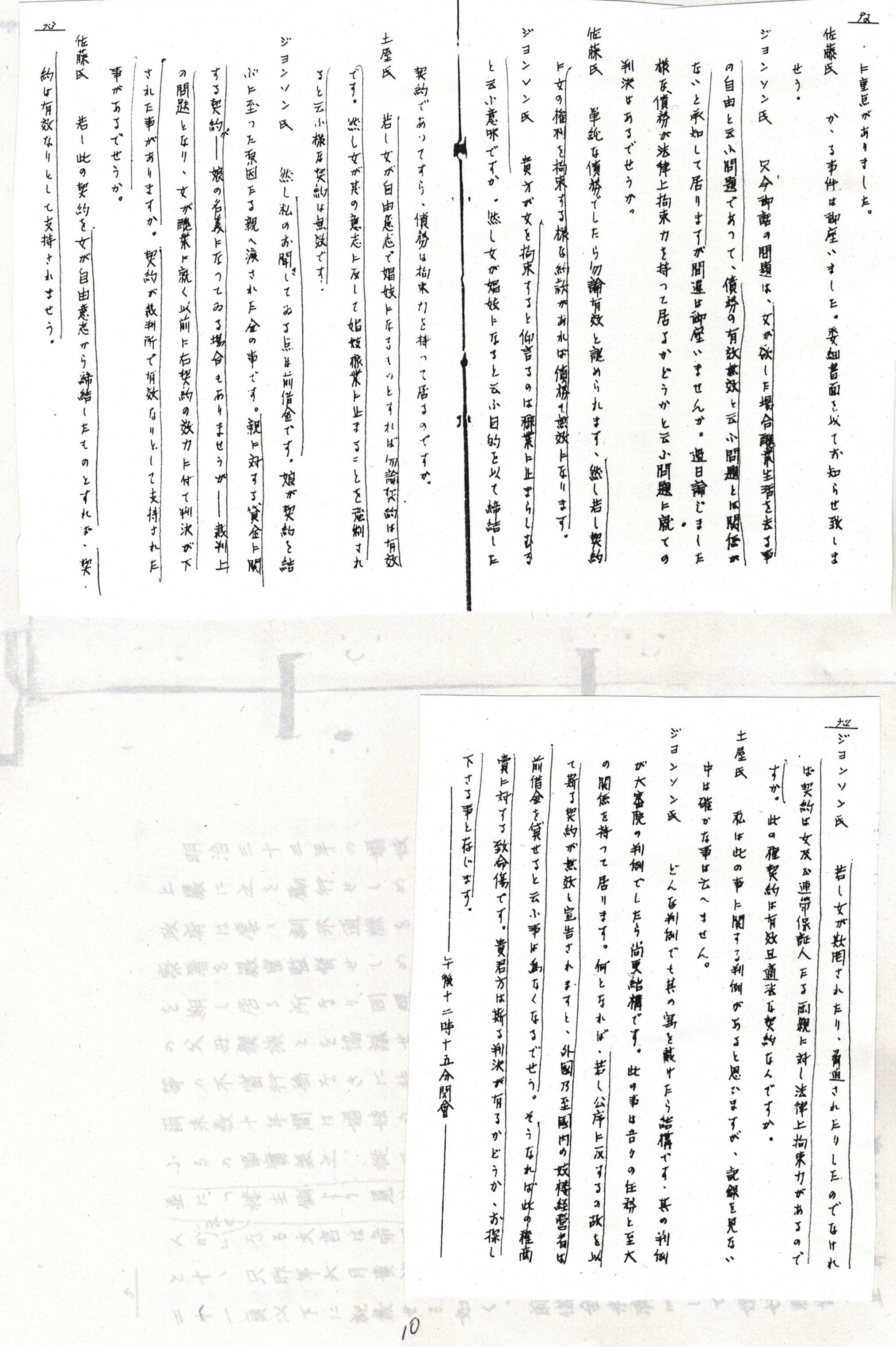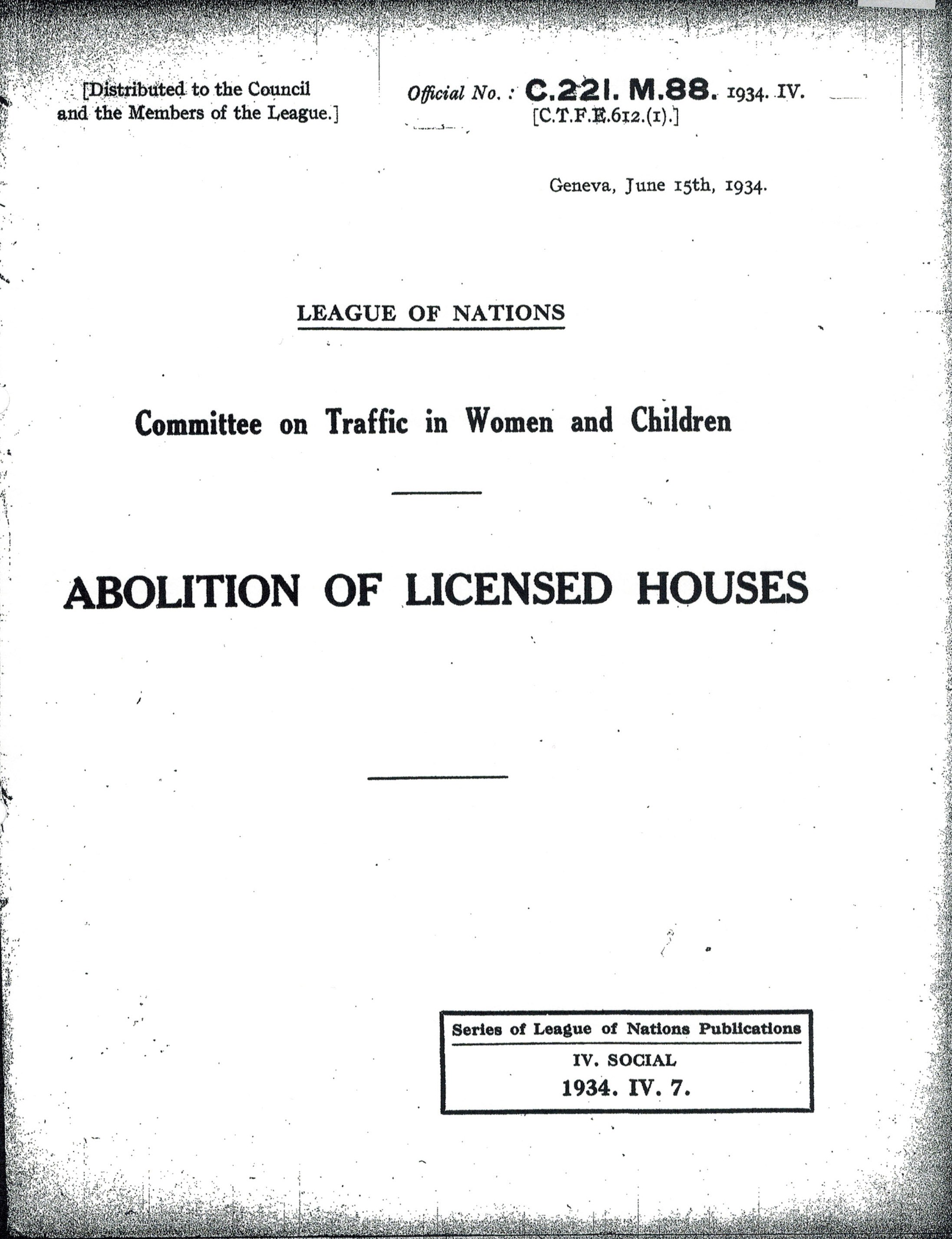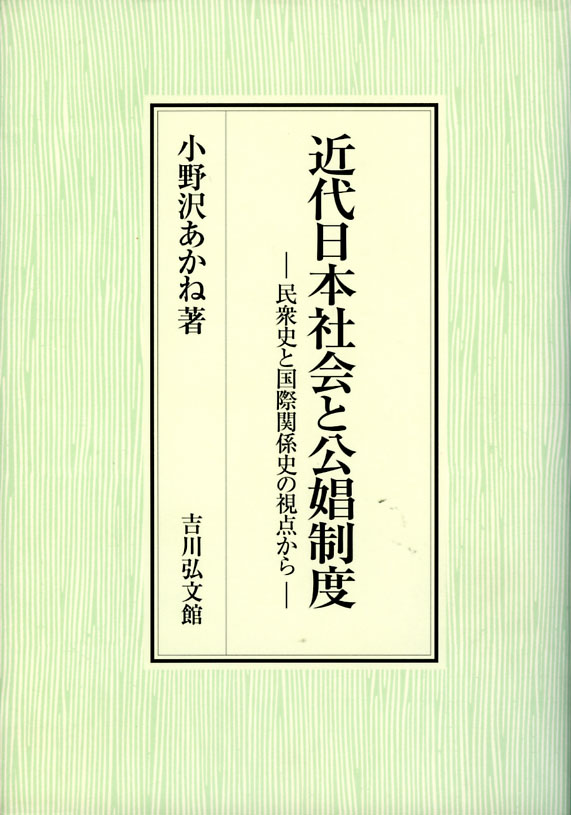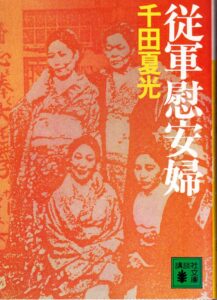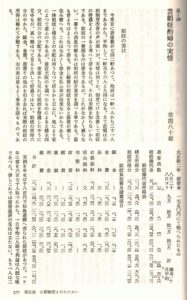To refute an argument that theianfuwho were embedded with the Japanese army were not, as is commonly reported, ‘sex slaves.’ They were working under a system of licensed prostitution that was commonplace around the world at the time, it was explained in an earlier section that comfort women weren’t licensed prostitutes, the licensed prostitution system itself was sexual slavery from Japan’s point of view even at that time, the Prostitution Abolition Movement was expanded, and the licensed prostitution system was planned to be abolished in the middle 1930s. Some people say that the licensed prostitution system also existed in the countries other than Japan, and it was unavoidable to sell poor women to prostitution at that time since it was a commercial transaction that was commonplace around the world at the time.
‘Investigator in the field investigation into the traffic in women and children in the East, June 12, 13 and 16th, 1931, Summary of the minutes of investigating committee at the official residence of Home Minister in Tokyo,’ “Issue of the field investigation into the traffic in women in the East” Vol.3, 1931.
However, this argument is completely wrong. The licensed prostitution system in Japan wasn’t commonplace elsewhere in the world. It is true that not only Japan but also the European countries adopted the licensed prostitution system in the pre-war days. Above all, France was known for having the system. Although they were similar in that prostitutes and brothels were registered with the police, the practices taking place under the system differed depending on the country. The practices of the licensed prostitution system in Japan seriously violated freedom and human rights of women. This is the first reason why the licensed prostitution system in Japan wasn’t commonplace in the world.
Differences from the Licensed Prostitution System in Europe
When women made ageishaor prostitution contract in pre-war Japan, their parents rather than they themselves, borrowed money called a cash advance from brothel owners orgeishahouse owners. The contract made their daughters pay off the debt through prostitution. So until the debt was paid off, their daughter had hardly any freedom of retirement. Moreover, a significant percentage of money customers paid for their prostitution was collected by pimps as revenue, and the debt was paid off from the remainder which was her share. So it took a long time to pay off the debt, and it often became impossible to pay it off due to increases in it. In Japanese society at that time, it was considered a virtue to devote oneself to parents or families. Such morality was taken advantage of to force women to lead lives of prostitution without freedom of retirement.
However, it is pointed out that licensed prostitutes in France were registered with the police but could easily retire. Although they sometimes borrowed money from licensed brothels, it wasn’t considered a virtue to devote oneself to parents or families and they weren’t forced to be under circumstances of sex slavery without personal liberty. In other words, it was different from the licensed prostitution system in Japan: their parents borrowed cash advances from brothels, daughters paid off the debt by undergoing prostitution, they were forced to endure prostitution until the debt was paid off without freedom of retirement, it was extremely difficult to pay off the debt since a significant percentage of money customers paid for their prostitution was collected by pimps as revenue, and, conversely, the debt often increased.
And it is pointed out that licensed prostitutes in the U.K., where the prostitutes registration system was introduced by the police in the late 19thcentury, had freedom of movement and could go to other regions and prostitution was nothing more than a temporary experience in their lives. They weren’t under circumstances of sex slavery in licensed brothels. In other words, the custom of selling daughters into prostitution under the licensed prostitution system in Japan wasn’t commonplace outside of Japan.
League of Nations Committee on Traffic in Women and Children, “Abolition of Licensed Houses”, Geneva, June 15th, 1934, Series of League of Nations Publications Ⅳ. Social, 1934. Ⅳ. 7, Official No.: C.221.M.88.1934.Ⅳ. 国立国会図書館所蔵
International Society Efforts toAbolish the Licensed Prostitution System and the System in Japan
The second reason why the licensed prostitution system in Japan wasn’t commonplace elsewhere in the world was that the Movement for Abolition of the Licensed Prostitution System had already been active since the end of the 19thcentury in Europe for the reason that the system violated the human rights of women and was useless in preventing sexually-transmitted diseases. For example, in the U.K., the Contagious Diseases Acts were enacted and enforced at military posts and naval ports in 1864. Women in designated areas regarded as prostitutes were registered as licensed prostitutes, supervised and required to have sexual disease examinations. This system, however, was abolished amid sharp criticism by feminists including Josephine Butler and the working classes. On the one hand men were allowed to hire prostitutes, but on the other hand the civil rights of women regarded as committing prostitution were restricted and they were forced to have examinations. This was criticized as a double standard of morality and the examinations were seen as equal to rape. Such criticism against prostitution and the licensed prostitution system grew throughout Europe including France which had adopted the licensed prostitution system.
Material owned by the Diplomatic Archives of the Ministry of Foreign Affairs, “An affair of the women and children issue in the League of Nations, Issue of the field investigation into the traffic in women in the East, Investigation report related to this country and Imperial memorandum”
In Europe at that time there was an expanding international traffic in women due to an increase in migrants and it was pointed out that the operators of prostitution businesses under the licensed prostitution system formed hotbeds of trafficking in women. the abolition of the licensed prostitution system and the suppression of the traffic in women came within the jurisdiction of the League of Nations and international treaties were enacted to abolish the licensed prostitution system and suppress the traffic in women in each country. As a result, the licensed prostitution system was abolished in not only the European countries but also the Western colonies in Southeast Asia (Indonesia, the Philippines and Singapore, etc.) in the 1920s. To the contrary, Japan had introduced and expanded the licensed prostitution system to such colonies as Taiwan and Korea, the Kwantung peninsula and its sphere of influence including the South Manchuria Railway in northern China zone since the 1910s.
In parallel with the trend to abolish licensed prostitution, international treaties to suppress the traffic in women were prepared at the League of Nations. The International Convention for the Suppression of the Traffic in Women and Children was enacted in the League of Nations in 1921, and it was prohibited to persuade women ①under the age of 21 to enter prostitution even if they had consented and ②aged 21 and over to enter prostitution in fraudulent or forcible ways. The Japanese government licensed women aged 18 and over to enter prostitution. Far from suppressing prostitution as intended by the convention, the Japanese government officially accepted it. Since the women didn’t have freedom of retirement until cash advances were paid off and they were extremely difficult to pay it off, they could be regarded as being forced to undergo prostitution. So the licensed prostitution system itself violated this convention. In contrast to the Western countries abolishing the licensed prostitution system including that in their colonies and enacting international treaties to suppress the traffic in women, the licensed prostitution system in Japan wasn’t “commonplace” at all.
Meanwhile, the League of Nations Committee on Traffic in Women and Children organized an Investigating Commission and investigated the actual conditions of international traffic in women in the American continent, North Africa, Europe and Asia. And after investigating the American continent, North Africa and Europe, it concluded that “licensed brothels undoubtedly promote (both domestic and international) human trafficking and the licensed prostitution system forms hotbeds of vice” in 1927.
In addition, the League of Nations organized an “Investigating Commission on the Traffic in Women in the East” in 1931. After investigating the Asian countries, the Commission visited Japan and paid attention to the actual conditions in which many Japanese women were sold from Japan to the Chinese continent. At the time, it sharply criticized the fact that freedom of retirement for women were violated under the custom of lending cash advances and operators were not prohibited but licensed to procure women for prostitution. The Japanese government officially announced that a cash advance contract was separate from ageishaand prostitution contract and the women weren’t forced to enter prostitution but worked according to their “own will” since they could retire even if they hadn’t paid off the cash advance. In other words, it continued concealing the reality thatgeishaand prostitutes were obliged to pay off cash advances and deprived of their freedom of retirement. As a matter of course, such replies from Japanese government officials were sharply criticized by the Commission at the investigation meeting and it was suggested that the government criminalise cash advance contracts and procurement of women for prostitution.
And after this investigation in the Far East, the League of Nations Committee on Traffic in Women and Children concluded in 1932 as follows:
“… the Commission holds that the principal factor in promotion of international traffic in women in the East is the brothel and, in the chain of brothels which are at the disposal of the trafficker, particularly the brothel in the place of destination of the victim. The most effective remedy against the evil, therefore, is, in the Commission’s opinion, the abolition of licensed or recognized brothels in the countries concerned.”
(League of Nations Committee on Traffic in Women and Children, “Abolition of Licensed Houses”, Geneva, June 15th, 1934, Series of League of Nations Publications Ⅳ. Social, 1934. Ⅳ. 7, Official No.: C.221.M.88.1934.Ⅳ. Owned by the National Diet Library)
Onozawa Akane, “Modern Japanese society and the licensed prostitution system―From the viewpoint of the history of people and international relations”, Yoshikawa Koubunkan, 2010.
In international society in the 1920s and 30s, the licensed prostitution system, especially that in Japan, was regarded by the League of Nations as the principal factor in the promotion of the international traffic in women and a system which had to be abolished. In response to this international trend, the Japanese government announced the abolition of the licensed prostitution system in 1934 (It wasn’t abolished, though.).
<References>
・Onozawa Akane, “Modern Japanese society and the licensed prostitution system―From the viewpoint of the history of people and international relations”, Yoshikawa Koubunkan, 2010.
・Judith R. Walkowitz, “Prostitution and Victorian Society”, Sophia University Press, 2009
・Alain Corbin, “Prostitutes”, Fujiwara Shoten, 1991.

